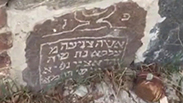According to the organization’s Chairman Johnny Daniels, the headstones were discovered in the town of Pełczyce. “Before the war, there were 1,300 Jewish cemeteries in Poland, while today only 40 remain. This means that over 1,000 cemeteries have simply been destroyed, with Poles taking the headstones and using them for anything imaginable, including houses and bathrooms.” While this isn’t new, Daniels nevertheless described the site of the repurposed headstones as “unusually painful.”
For Daniels, the case emphasizes the importance of preserving the memory of the Holocaust. “Everything we think about in relation to the (European) generation of the Holocaust as well as previous generations is still alive. This isn’t just a place to visit and see the extermination camps, there are still things that need to be done. We are the last generation that will be in contact with Holocaust survivors. Our children won’t have that, so we need to pass on this message.”
Daniels feels that highlighting the use of Jewish headstones as building materials allows Mi’ma’amakim to start a broader dialogue on the subject. “Everything we can think of has been made from headstones, and by raising this issue we are able to shed light on even more substantial elements that make up the memory of the Holocaust.”
Daniels added that his organization has received help and cooperation from several Polish institutes regarding the headstones, and that some even approach them in order to return them to their former resting places.


















